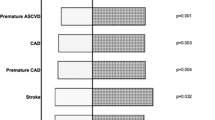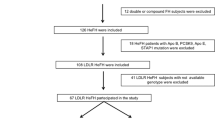Abstract
Aims
Inflammation is a key regulatory process that links hypercholesterolemia and immune mechanisms promoting atherosclerosis. Inflammatory biomarkers may be helpful to better define the atherosclerotic burden in patients with high cholesterol levels such as familial hypercholesterolemia (FH). Our aim was to evaluate the concentration of S100A12 protein in FH patients and its association with pulse wave velocity (PWV).
Methods
We measured glucose and lipid profile, S100A12, sRAGE, esRAGE and PWV in 39 patients with a genetically confirmed diagnosis of FH and 39 hypercholesterolemic subjects without a clinical diagnosis of FH (Dutch score ≤ 3). All subjects were on statin treatment at the time of the enrollment.
Results
No difference of glucose and lipid profile was found in the two groups. FH patients had higher S100A12 plasma levels than non-FH subjects (12.87 ± 4.82 vs. 8.57 ± 4.87 ng/mL, p < 0.01). No difference of hs-CRP, sRAGE and esRAGE was found between the two groups. Also, PWV was higher in FH patients than non-FH subjects (8.63 ± 0.92 vs. 6.68 ± 0.73 m/s, p < 0.05). Finally, S100A12 was independently correlated with age (p < 0.01), genetic mutation (p < 0.01) and PWV (p < 0.001).
Conclusions
FH patients exhibited higher S100A12 levels than non-FH subjects. A novel vascular inflammation pathway, other than hs-CRP, might be useful to better characterize cardiovascular risk profile.

Similar content being viewed by others
References
Havel RJ (1989) Biology of cholesterol, lipoproteins and atherosclerosis. Clin Exp Hypertens Part A Theory Pract 11:887–900. https://doi.org/10.3109/10641968909035380
Borén J, Williams KJ (2016) The central role of arterial retention of cholesterol-rich apolipoprotein-B-containing lipoproteins in the pathogenesis of atherosclerosis: a triumph of simplicity. Curr Opin Lipidol 27:473–483. https://doi.org/10.1097/MOL.0000000000000330
GBD 2013 Mortality and Causes of Death Collaborators (2015) Global, regional, and national age-sex specific all-cause and cause-specific mortality for 240 causes of death, 1990–2013: a systematic analysis for the Global Burden of Disease Study 2013. Lancet (London, England) 385:117–171. https://doi.org/10.1016/S0140-6736(14)61682-2
Hansson GK (2005) Inflammation, atherosclerosis, and coronary artery disease. N Engl J Med 352:1685–1695. https://doi.org/10.1056/NEJMra043430
Ridker PM, Everett BM, Thuren T et al (2017) Antiinflammatory therapy with canakinumab for atherosclerotic disease. N Engl J Med 377:1119–1131. https://doi.org/10.1056/NEJMoa1707914
Hansson GK, Libby P (2006) The immune response in atherosclerosis: a double-edged sword. Nat Rev Immunol 6:508–519. https://doi.org/10.1038/nri1882
van Dijk RA, Duinisveld AJF, Schaapherder AF et al (2015) A change in inflammatory footprint precedes plaque instability: a systematic evaluation of cellular aspects of the adaptive immune response in human atherosclerosis. J Am Heart Assoc 4:e001403. https://doi.org/10.1161/JAHA.114.001403
Lebedeva A, Vorobyeva D, Vagida M et al (2017) Ex vivo culture of human atherosclerotic plaques: a model to study immune cells in atherogenesis. Atherosclerosis 267:90–98. https://doi.org/10.1016/j.atherosclerosis.2017.10.003
Pirillo A, Garlaschelli K, Arca M et al (2017) Spectrum of mutations in Italian patients with familial hypercholesterolemia: new results from the LIPIGEN study. Atheroscler Suppl 29:17–24. https://doi.org/10.1016/j.atherosclerosissup.2017.07.002
Averna M, Cefalù AB, Casula M et al (2017) Familial hypercholesterolemia: the Italian atherosclerosis society network (LIPIGEN). Atheroscler Suppl 29:11–16. https://doi.org/10.1016/j.atherosclerosissup.2017.07.001
Basta G (2008) Receptor for advanced glycation endproducts and atherosclerosis: from basic mechanisms to clinical implications. Atherosclerosis 196:9–21. https://doi.org/10.1016/j.atherosclerosis.2007.07.025
Koyama H, Nishizawa Y (2010) AGEs/RAGE in CKD: irreversible metabolic memory road toward CVD? Eur J Clin Investig 40:623–635. https://doi.org/10.1111/j.1365-2362.2010.02298.x
Hofmann MA, Drury S, Fu C et al (1999) RAGE mediates a novel proinflammatory axis: a central cell surface receptor for S100/calgranulin polypeptides. Cell 97:889–901
Hofmann Bowman MA, Schmidt AM (2011) S100/calgranulins EN-RAGEing the blood vessels: implications for inflammatory responses and atherosclerosis. Am J Cardiovasc Dis 1:92–100
Yang Z, Tao T, Raftery MJ et al (2001) Proinflammatory properties of the human S100 protein S100A12. J Leukoc Biol 69:986–994
Kosaki A, Hasegawa T, Kimura T et al (2004) Increased plasma S100A12 (EN-RAGE) levels in patients with type 2 Diabetes. J Clin Endocrinol Metab 89:5423–5428. https://doi.org/10.1210/jc.2003-032223
Foell D, Kane D, Bresnihan B et al (2003) Expression of the pro-inflammatory protein S100A12 (EN-RAGE) in rheumatoid and psoriatic arthritis. Rheumatology 42:1383–1389. https://doi.org/10.1093/rheumatology/keg385
Gawdzik J, Mathew L, Kim G et al (2011) Vascular remodeling and arterial calcification are directly mediated by S100A12 (EN-RAGE) in chronic kidney disease. Am J Nephrol 33:250–259. https://doi.org/10.1159/000324693
Yonekura H, Yamamoto Y, Sakurai S et al (2003) Novel splice variants of the receptor for advanced glycation end-products expressed in human vascular endothelial cells and pericytes, and their putative roles in diabetes-induced vascular injury. Biochem J 370:1097–1109. https://doi.org/10.1042/BJ20021371
Di Pino A, Mangiafico S, Urbano F et al (2017) HbA < inf > 1c </inf > identifies subjects with prediabetes and subclinical left ventricular diastolic dysfunction. J Clin Endocrinol Metab. https://doi.org/10.1210/jc.2017-00954
Ikonomidis I, Makavos G, Lekakis J (2015) Arterial stiffness and coronary artery disease. Curr Opin Cardiol 30:1. https://doi.org/10.1097/HCO.0000000000000179
Scicali R, Di Pino A, Platania R et al (2018) Detecting familial hypercholesterolemia by serum lipid profile screening in a hospital setting: Clinical, genetic and atherosclerotic burden profile. Nutr Metab Cardiovasc Dis. https://doi.org/10.1016/j.numecd.2017.07.003
Nordestgaard BG, Chapman MJ, Humphries SE et al (2013) Familial hypercholesterolaemia is underdiagnosed and undertreated in the general population: guidance for clinicians to prevent coronary heart disease: consensus statement of the European Atherosclerosis Society. Eur Heart J 34:3478–90a. https://doi.org/10.1093/eurheartj/eht273
Stone NJ, Robinson JG, Lichtenstein AH et al (2014) 2013 ACC/AHA guideline on the treatment of blood cholesterol to reduce atherosclerotic cardiovascular risk in adults. J Am Coll Cardiol 63:2889–2934. https://doi.org/10.1016/j.jacc.2013.11.002
Ryan H, Trosclair A, Gfroerer J (2012) Adult current smoking: differences in definitions and prevalence estimates—NHIS and NSDUH, 2008. J Environ Public Health 2012:918368. https://doi.org/10.1155/2012/918368
International Federation of Clinical Chemistry and Laboratory Medicine, IFCC Scientific Division IF of C, Mosca A, Goodall I et al (2007) Global standardization of glycated hemoglobin measurement: the position of the IFCC working group. Clin Chem Lab Med 45:1077–1080. https://doi.org/10.1515/CCLM.2007.246
Di Pino A, Currenti W, Urbano F et al (2017) High intake of dietary advanced glycation end-products is associated with increased arterial stiffness and inflammation in subjects with type 2 diabetes. Nutr Metab Cardiovasc Dis. https://doi.org/10.1016/j.numecd.2017.06.014
Mori Y, Kosaki A, Kishimoto N et al (2009) Increased plasma S100A12 (EN-RAGE) levels in hemodialysis patients with atherosclerosis. Am J Nephrol 29:18–24. https://doi.org/10.1159/000148646
Di Pino A, Urbano F, Zagami RM et al (2016) Low endogenous secretory receptor for advanced glycation end-products levels are associated with inflammation and carotid atherosclerosis in prediabetes. J Clin Endocrinol Metab 101:1701–1709. https://doi.org/10.1210/jc.2015-4069
Scicali R, Giral P, Gallo A et al (2016) HbA1c increase is associated with higher coronary and peripheral atherosclerotic burden in non diabetic patients. Atherosclerosis 255:102–108. https://doi.org/10.1016/j.atherosclerosis.2016.11.003
Ross R (1999) Atherosclerosis—an inflammatory disease. N Engl J Med 340:115–126. https://doi.org/10.1056/NEJM199901143400207
Menini S, Iacobini C, Ricci C et al (2013) The galectin-3/RAGE dyad modulates vascular osteogenesis in atherosclerosis. Cardiovasc Res 100:472–480. https://doi.org/10.1093/cvr/cvt206
Mollazadeh H, Carbone F, Montecucco F et al (2018) Oxidative burden in familial hypercholesterolemia. J Cell Physiol. https://doi.org/10.1002/jcp.26466
Scicali R, Di Pino A, Ferrara V et al (2018) New treatment options for lipid-lowering therapy in subjects with type 2 diabetes. Acta Diabetol. https://doi.org/10.1007/s00592-017-1089-4
Benn M, Watts GF, Tybjaerg-Hansen A, Nordestgaard BG (2012) Familial hypercholesterolemia in the danish general population: prevalence, coronary artery disease, and cholesterol-lowering medication. J Clin Endocrinol Metab 97:3956–3964. https://doi.org/10.1210/jc.2012-1563
Ligthart S, Sedaghat S, Ikram MA et al (2014) EN-RAGE: a novel inflammatory marker for incident coronary heart disease. Arterioscler Thromb Vasc Biol 34:2695–2699. https://doi.org/10.1161/ATVBAHA.114.304306
Nowak C, Carlsson AC, Östgren CJ et al (2018) Multiplex proteomics for prediction of major cardiovascular events in type 2 diabetes. Diabetologia 61:1748–1757. https://doi.org/10.1007/s00125-018-4641-z
Di Pino A, Scicali R, Calanna S et al (2014) Cardiovascular risk profile in subjects with prediabetes and new-onset type 2 diabetes identified by HbA1c according to american diabetes association criteria. Diabetes Care 37:1447–1453. https://doi.org/10.2337/dc13-2357
Quade-Lyssy P, Kanarek AM, Baiersdörfer M et al (2013) Statins stimulate the production of a soluble form of the receptor for advanced glycation end products. J Lipid Res 54:3052–3061. https://doi.org/10.1194/jlr.M038968
Ridker PM, Danielson E, Fonseca FA et al (2009) Reduction in C-reactive protein and LDL cholesterol and cardiovascular event rates after initiation of rosuvastatin: a prospective study of the JUPITER trial. Lancet (London, England) 373:1175–1182. https://doi.org/10.1016/S0140-6736(09)60447-5
Scicali R, Rosenbaum D, Di Pino A et al (2018) An increased waist-to-hip ratio is a key determinant of atherosclerotic burden in overweight subjects. Acta Diabetol. https://doi.org/10.1007/s00592-018-1144-9
Acknowledgements
F.P. is the guarantor of this work and, as such, had full access to all the data in the study and takes responsibility for the integrity of the data and the accuracy of the data analysis. All authors approved the final version. The authors wish to thank the Department of Clinical and Experimental Medicine for financial support in the context of the 2016/2018 Department Research Plan of University of Catania (Project #A). The authors wish to thank the Lipid TransPort Disorders Italian Genetic Network (LIPIGEN) study for financial support to carry out genetic analysis. The authors wish to thank the Scientific Bureau of the University of Catania for language support.
Funding
This research did not receive any specific grant from funding agencies in the commercial or not-for-profit sectors.
Author information
Authors and Affiliations
Contributions
RS contributed to the study design, researched data, contributed to the discussion, and wrote the article. ADP contributed to the study design, researched data, contributed to the discussion, and reviewed and edited the article. FU, VF, SDM, SM, AS, AF, researched data, contributed to the discussion, and reviewed and edited the article. SP and AMR contributed to the study design and discussion, and reviewed and edited the article. FP designed the study, researched data, contributed to the discussion, and reviewed and edited the article.
Corresponding author
Ethics declarations
Conflict of interest
The authors have no conflicts of interest to disclose.
Ethical approval
This study has been approved by the local ethic committee in accordance with the ethical standards of the institutional and national research committee and with the 1964 Declaration of Helsinki and its later amendments or comparable ethical standards. This article does not contain any studies with animals performed by any of the authors.
Informed consent
Informed consent was obtained from each participants included in the study.
Additional information
Managed by Massimo Federici.
Publisher's Note
Springer Nature remains neutral with regard to jurisdictional claims in published maps and institutional affiliations.
Electronic supplementary material
Below is the link to the electronic supplementary material.
Rights and permissions
About this article
Cite this article
Scicali, R., Di Pino, A., Urbano, F. et al. Analysis of S100A12 plasma levels in hyperlipidemic subjects with or without familial hypercholesterolemia. Acta Diabetol 56, 899–906 (2019). https://doi.org/10.1007/s00592-019-01338-1
Received:
Accepted:
Published:
Issue Date:
DOI: https://doi.org/10.1007/s00592-019-01338-1




